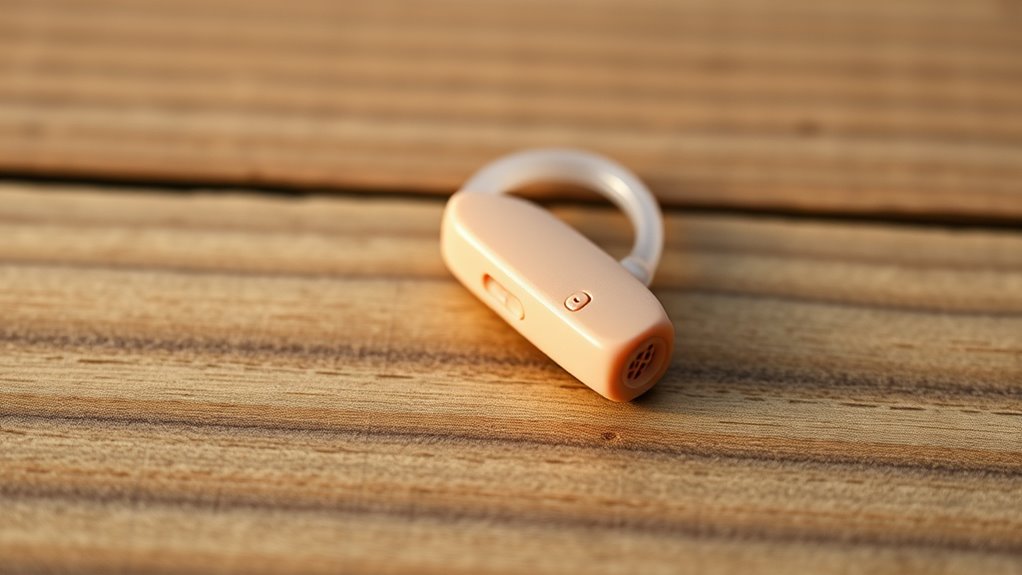Hearing aids come in various styles, like behind-the-ear, in-the-ear, and receiver-in-canal, each offering different comfort and visibility options. They include features such as noise reduction, directional microphones, and Bluetooth connectivity to improve sound clarity and make your listening experience more natural. Battery options range from disposable to rechargeable, depending on your lifestyle. Exploring these styles and features can help you find the best fit for your needs and lifestyle. Keep exploring to discover more about how these innovations can enhance your hearing.
Key Takeaways
- Hearing aids come in various styles, including behind-the-ear, in-the-ear, and receiver-in-canal designs to suit different preferences.
- Key features include noise reduction, directional microphones, and connectivity options like Bluetooth for improved hearing and streaming.
- Battery types vary between disposable and rechargeable, impacting convenience and device maintenance.
- Modern hearing aids often automatically adjust settings based on environmental noise levels for optimal performance.
- Selecting the right style and features depends on lifestyle, hearing loss severity, and personal comfort preferences.

Have you ever wondered how hearing aids work to improve your hearing? When you wear one, it captures sounds from your environment, processes them, and delivers clearer audio directly into your ear canal. Behind the scenes, several features work together to make this possible, starting with the power source. Battery types vary, but most modern hearing aids use small, rechargeable or disposable batteries. Disposable batteries come in sizes like 10, 312, 13, and 675, each fitting different device models and providing varying durations of power. Rechargeable batteries, often lithium-ion, are increasingly popular because they can be charged overnight, eliminating the need for frequent replacements. Your choice depends on lifestyle, convenience, and the specific hearing aid model you select.
Hearing aids use batteries—disposable or rechargeable—to power advanced sound processing features.
Noise reduction is another critical feature that enhances your hearing experience. In noisy environments like restaurants or social gatherings, your hearing aid actively filters out background noise, helping you focus on speech and important sounds. It does this through sophisticated algorithms that analyze incoming sound, identifying and minimizing unwanted noise while preserving speech clarity. Some hearing aids even automatically adjust noise reduction settings based on the environment, so you don’t have to manually change them. This technology makes conversations more natural and less tiring, especially over extended periods.
Modern hearing aids also incorporate features like directional microphones, which work in tandem with noise reduction to focus on sounds coming from in front of you. This helps you hear conversations more clearly without being overwhelmed by surrounding noise. Additionally, some devices have connectivity options such as Bluetooth, allowing you to stream audio directly from your phone or other devices. These features enhance your overall hearing experience, making it more seamless and integrated into daily life.
Battery maintenance is an essential aspect of ensuring your hearing aids function at their best. If you use disposable batteries, it’s helpful to keep spare sets on hand and to change them when you notice a decrease in sound quality or volume. For rechargeable models, regular charging cycles keep the device ready to go, often with indicators that show when the battery is running low. Properly maintaining your hearing aid batteries and understanding noise reduction capabilities ensure you get the most out of your device. Additionally, understanding technology advancements in hearing aids can help you make informed choices about the best features for your needs.
Frequently Asked Questions
How Do I Choose the Right Hearing Aid Style for My Lifestyle?
To choose the right hearing aid style for your lifestyle, consider your activity compatibility and daily routines. If you’re active or prefer discreet options, in-the-ear or behind-the-ear models might suit you best. For frequent social interactions, look for devices with features like noise reduction. Think about how easy it is to handle and maintain each style, ensuring it fits comfortably and meets your lifestyle considerations for seamless hearing aid use.
What Maintenance Is Required to Keep My Hearing Aid Functioning Properly?
Ever wonder how to keep your hearing aid working smoothly? You should regularly replace the batteries and clean the ear canal to prevent wax buildup. Gently wipe the device with a soft, dry cloth and use a cleaning tool to remove debris. Don’t forget to check the battery life often and replace it when needed. Proper maintenance guarantees your hearing aid stays effective and lasts longer, making every conversation clearer.
Are Hearing Aids Suitable for All Types of Hearing Loss?
Hearing aids are suitable for most types of hearing loss, but your specific needs depend on hearing loss variability and the latest hearing aid technology. Some styles work better for mild to moderate loss, while others are designed for severe cases. You should consult an audiologist, who can recommend the best hearing aid style and features tailored to your hearing loss, ensuring ideal sound quality and comfort.
How Long Does It Typically Take to Adapt to a New Hearing Aid?
Think of adapting to new hearing aids like planting a seed; it takes time to grow. Usually, hearing aid adjustment happens within a few days to weeks, but full adaptation can take up to a month. During this period, you’ll become accustomed to sounds you haven’t heard in a while. Be patient, follow your audiologist’s advice, and give yourself time to fully embrace the clarity and comfort your new devices offer.
Can Hearing Aids Be Used With Other Medical Devices?
Yes, you can use hearing aids with other medical devices, but medical device compatibility is essential. Some devices, like cochlear implants or certain medical monitors, may cause hearing aid interference, affecting performance. Always consult your audiologist or healthcare provider before pairing your hearing aid with other devices. They can guarantee safe use and minimize interference, helping you enjoy both devices without issues.
Conclusion
Now that you know the basics of hearing aid styles and features, you’re better equipped to find the right fit for your needs. Remember, choosing the right hearing aid can considerably improve your quality of life—so why settle for less? Take the time to explore your options and consult with professionals. After all, isn’t hearing the world around you worth the effort? Your journey to better hearing starts today.









